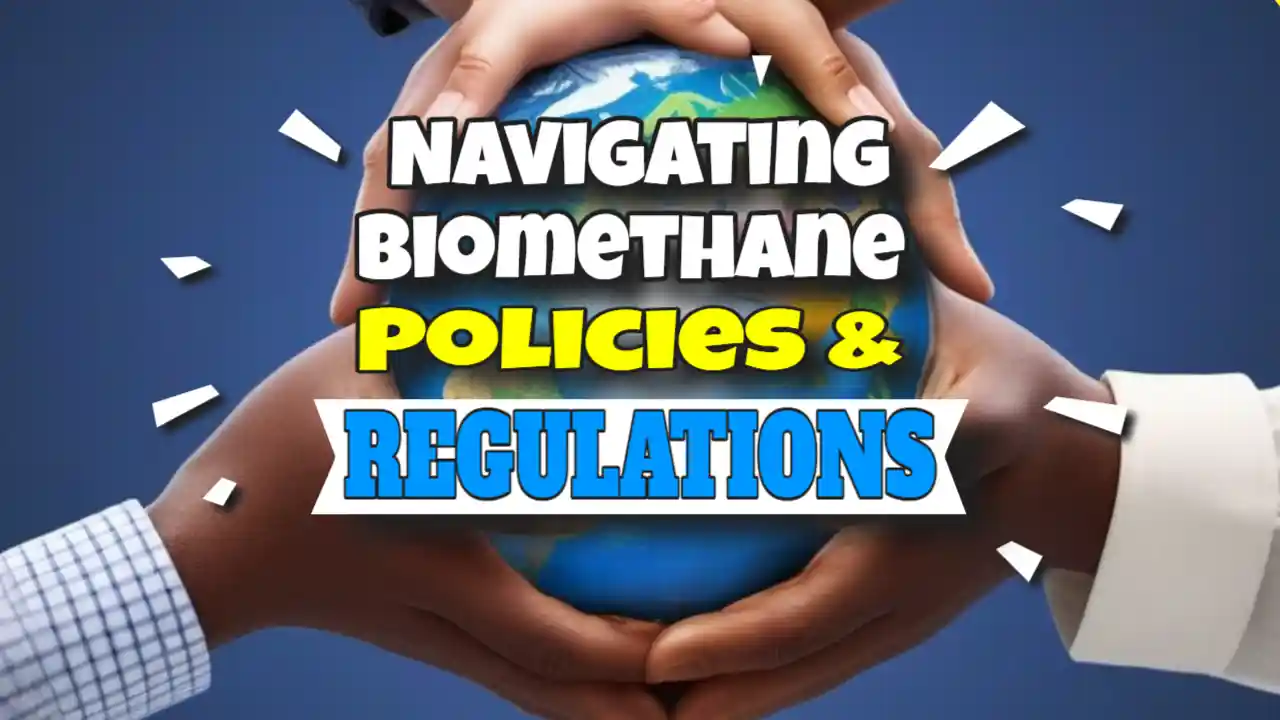Biomethane is not just a buzzword in the renewable energy sector; it’s a transformative solution that bridges waste management and energy production. As we delve deeper into its potential, understanding its opportunities and challenges becomes essential for stakeholders and advocates alike.
What You Will Learn
- Understanding Biomethane: Learn about biomethane’s role as a renewable energy source derived from organic materials, emphasizing its dual function in waste management and energy generation.
- Environmental Impact: Discover how biomethane reduces greenhouse gas emissions and landfill waste, contributing to a more sustainable energy landscape.
- Challenges to Adoption: Identify key barriers such as complex regulations, funding difficulties, and public misconceptions that hinder the growth of biomethane projects.
- Future Opportunities: Explore the future of biomethane through innovative technologies, public-private partnerships, and policy incentives that can enhance its adoption and effectiveness.
- Community Engagement: Understand the importance of fostering discussions and collaborations to advance biomethane technologies and broaden public awareness.
An In-Depth Overview of Biomethane Challenges and Opportunities
Biomethane, a renewable energy source derived from organic materials, is gaining traction as a viable alternative to fossil fuels. It is produced through the process of anaerobic digestion, where microorganisms break down organic matter in the absence of oxygen. This process not only reduces waste but also generates a cleaner fuel, making biomethane significant in our quest for sustainable energy.
The importance of biomethane lies in its ability to mitigate environmental impacts while supporting energy independence. Biomethane can be used in various applications, including electricity generation, heating, and as a fuel for vehicles. By harnessing this resource, we can reduce greenhouse gas emissions and contribute to a more sustainable energy future.

Understanding Biomethane: Definition and Significance
Biomethane is essentially purified biogas, containing high concentrations of methane, which is the primary component of natural gas. It’s crucial to understand this distinction, as biomethane can be injected into the natural gas grid or used as a vehicle fuel, providing a flexible energy solution. The significance of biomethane lies in its dual role of waste management and renewable energy generation.
Here are some key points about biomethane:
- Renewable Source: Biomethane is produced from organic materials such as agricultural residues, food waste, and manure.
- Energy Diversification: It provides a sustainable alternative to conventional fossil fuels.
- Environmental Benefits: Reduces landfill waste and greenhouse gas emissions.
Why Biomethane Matters in the Renewable Energy Landscape
In the broader context of renewable energy, biomethane plays a pivotal role. It complements other renewable sources, like solar and wind, by providing baseload energy generation. This means that while solar and wind production can be intermittent, biomethane offers a more consistent energy supply, helping to stabilize the grid.
Additionally, the development of biomethane contributes to energy security by utilizing locally sourced materials, which reduces dependency on imported fossil fuels. This local sourcing can also stimulate economic growth by creating jobs in rural areas involved in the production and processing of organic waste.
Addressing Current Barriers to Biomethane Adoption
While the potential of biomethane is promising, several challenges hinder its widespread adoption. From regulatory hurdles to funding issues, these barriers need to be addressed to unlock the full potential of this renewable energy source. Understanding these challenges is essential for stakeholders in the biomethane sector.
Here are some of the key barriers to consider:
- Regulatory Hurdles: Complex regulations can slow down project development.
- Funding Challenges: Securing investment for new projects can be difficult.
- Public Awareness: Lack of understanding can lead to resistance from the community.
Regulatory Hurdles: Navigating Compliance and Legislation
One of the most significant barriers to biomethane adoption is the complex landscape of regulations and compliance. Various laws at local, national, and international levels dictate how biomethane projects can be developed and implemented. Understanding these regulations is crucial for ensuring project viability and success.
Some regulatory challenges include:
- Environmental Regulations: Compliance with strict environmental standards can delay projects.
- Interconnection Standards: Navigating grid connection requirements can be cumbersome.
- Incentive Programs: Lack of clear incentives can deter investment in biomethane.
Funding and Investment Challenges in Biomethane Projects
Securing funding is another major challenge for biomethane projects. Investors often perceive renewable energy projects as high-risk, especially in the early stages. As a result, many biomethane initiatives struggle to attract the necessary financial backing to get off the ground.
Key factors affecting funding include:
- High Initial Costs: The capital needed for technology and infrastructure can be substantial.
- Uncertain Returns: Potential investors may be hesitant due to uncertain market conditions.
- Lack of Awareness: Knowledge gaps about biomethane’s benefits can result in fewer investment opportunities.

Comparative Analysis: Biomethane vs. Other Renewable Energies
To fully appreciate biomethane’s potential, it’s essential to compare it with other renewable energy sources. Each source has unique advantages and disadvantages that make them suitable for different applications. By understanding these differences, we can better position biomethane within the renewable energy landscape.
Here’s a brief comparison:
- Solar Energy: Excellent for generating electricity but limited by weather conditions.
- Wind Energy: Great for large-scale power generation but can be intermittent.
- Hydropower: Consistent energy but can have significant environmental impacts.
- Biomethane: Reliable, can utilize waste, and offers flexible applications.
Summarizing Key Insights into Biomethane’s Landscape
Biomethane is a powerful player in the renewable energy field, but it also faces several challenges. To really understand its potential, we must dive into the barriers while also spotting the opportunities that lie ahead. As we look at the landscape, it becomes clear that collaboration and innovation are key to overcoming these hurdles and advancing the adoption of biomethane.
In summary, addressing the regulatory hurdles, funding issues, and public perceptions can pave the way for a sustainable future. By highlighting the significance of biomethane and the role it plays in our energy needs, we can inspire greater interest and investment in this vital resource.
Bridging the Gap: Overcoming Challenges for Greater Adoption
To boost the adoption of biomethane, we can focus on several strategies that address existing challenges. Here are some key areas to target:
- Streamlining Regulations: Simplifying compliance can facilitate smoother project approvals.
- Increasing Funding Resources: Expanding funding options can help minimize financial barriers.
- Enhancing Public Education: Raising awareness can shift public opinion positively towards biomethane.
By taking these steps, we can create a more favorable environment for biomethane projects. This, in turn, will lead to increased investment and innovation, fueling growth in this renewable energy sector!
Harnessing Opportunities: The Future of Biomethane in Renewable Energy
The future of biomethane looks promising, especially as we unlock opportunities within the renewable energy sector. To fully harness its potential, we should consider:
- Innovative Technologies: Embracing cutting-edge methods in production can enhance efficiency.
- Public-Private Partnerships: Collaborations can boost resources and maximize project impact.
- Incentives for Adoption: Implementing policies that encourage biomethane use can drive growth.
With these opportunities at hand, we can envision a world where biomethane plays a critical role in our energy mix. By continuing to explore and invest in this resource, we can ensure a sustainable future for generations to come!
Encouraging Engagement and Further Exploration
Engagement is crucial when it comes to advancing the conversation around biomethane. As public interest grows, so too does the potential for innovative solutions to emerge. It’s essential to foster discussions that encourage everyone to contribute their ideas and insights!
By creating platforms where experts and enthusiasts can share knowledge, we can build a robust community focused on biomethane technologies and trends. Together, we can tackle challenges and champion opportunities within this exciting field.
Join the Conversation on Biomethane Technologies and Trends
I invite you to take part in discussions about biomethane! Engaging with others can bring new perspectives and solutions to light. Consider joining forums, attending webinars, or participating in local initiatives centered around biomethane.
- Share your experiences and insights with others.
- Participate in local clean energy events.
- Collaborate with organizations dedicated to promoting biomethane.
Together, we can foster a vibrant dialogue that propels the biomethane sector forward.
Stay Informed: Subscribe for Updates on Biomethane Developments
Staying updated on the latest in biomethane is vital for anyone interested in renewable energy. Subscribing to newsletters or following industry sites can provide you with the information you need to stay ahead!
Consider following sources that offer:
- News articles and research papers on biomethane.
- Updates on policy changes and funding opportunities.
- Insights on technological advancements in the field.
By staying informed, you can be an active participant in the growth of biomethane and contribute to a sustainable future!
Comparative Analysis of Biomethane vs. Other Renewable Energies
Energy Source:
Solar Energy
Excellent for generating electricity
Limited by weather conditions
Wind Energy
Great for large-scale power generation
Can be intermittent
Hydropower
Consistent energy
Significant environmental impacts
Biomethane
Reliable 24/7 energy
Utilizes waste
Offers flexible applications
Key Insights
Each energy source has unique strengths and weaknesses, positioning biomethane as a flexible and reliable option in the renewable energy landscape.
You Also May Like to Read Our Other Biomethane Articles Such as:
Frequently Asked Questions (FAQs)
- What is biomethane? Biomethane is a purified form of biogas that contains high concentrations of methane, produced from organic materials through anaerobic digestion.
- How does biomethane contribute to waste management? Biomethane production helps reduce landfill waste by converting organic materials into a usable energy source.
- What are the environmental benefits of using biomethane? Biomethane reduces greenhouse gas emissions and supports a sustainable energy future by providing cleaner fuel alternatives.
- What barriers exist for biomethane adoption? Key barriers include complex regulations, funding challenges, and public misconceptions about the technology.
- How can we overcome challenges to biomethane adoption? Strategies include streamlining regulations, increasing funding resources, and enhancing public education about the benefits of biomethane.
- What is the future of biomethane in renewable energy? The future looks promising with opportunities for innovative technologies, public-private partnerships, and policies that incentivize biomethane use.




Leave a Reply